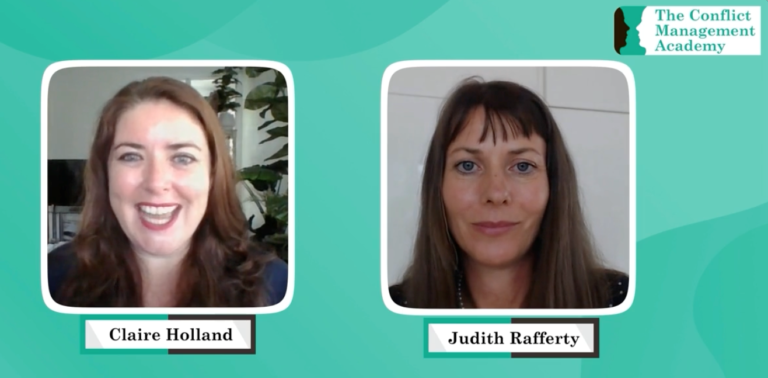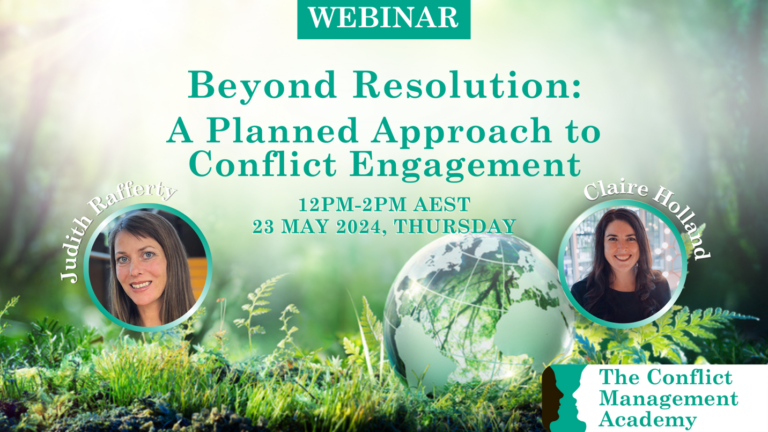Claire Holland and Judith Rafferty, conflict management specialists, academics, researchers and trainers with the Conflict Management Academy (CMA), say YES! According to Judith and Claire, frameworks are a useful way to break down and look at complicated conflict situations in a way that can bring greater awareness, understanding, and clarity to the situation. It’s not suggested that frameworks simplify the conflict, but that they are useful to make the conflict appear more manageable.

Practically, a framework can help to better understand a complex conflict by allowing the user to view the conflict through different lenses. Frameworks can also suggest multiple ways of thinking about the issues at hand, help the user to develop a more detailed and holistic picture of the conflict, and then consider multiple opportunities to work with the conflict. Claire and Judith suggest that using frameworks in conflict management contexts have multiple benefits, including:
Assisting conflict management specialists, like mediators, conflict management coaches, and HR professionals, to work with clients to gather necessary information about the conflict and its context, and decide on next steps.
Supporting clients to take a step back or ‘go to the balcony’ and perhaps not react out of habit and prior learned behaviour, but to suspend judgement on the situation until a more holistic analysis of the situation has been conducted.
Thinking about future options that might be quite different from a conflict parties’ initial reaction to the situation once the conflict has been considered through different lenses.
Focusing on long term strategies to manage the conflict by considering how the conflict may play out overtime. Looking at a conflict through an analytical lens and framework helps the user to determine if the issues in the conflict are suited to resolution or require alternative approaches to manage the conflict.

Conflict Analysis Framework
Drawing on years of teaching, research, and conflict management practice, Judith and Claire, have developed a framework to support conflict management specialists and conflict parties better understand ‘what is going on’ in a conflict situation. Drawing on multidisciplinary scholarship, including conflict studies, psychology, management, history, political science, etc. the Conflict Analysis Framework guides users through a step-by-step process to compartmentalise a complex conflict into more manageable segments for analysis.
Spencer, Barry, and Ojelabi in their text Dispute Resolution in Australia provide only a short commentary on conflict analysis. While they note that it’s not easy to analyse complex conflicts, they suggest that conflict specialists would ideally have knowledge of multiple analytical tools and models to help them collect information about the conflict, understand the conflict dynamics and to support the conflict parties to constructively manage or resolve the conflict. Condliffe, in his text Conflict Management: A practical guide, leads the reader through a process of ‘understanding conflict’ and presents several considerations in ‘responding to conflict’. Condliffe outlines several models of conflict but does not provide a clear overarching framework for analysis.
Several scholars and practitioners have introduced frameworks or tools to support conflict analysis. For example, Furlong, in his book The Conflict Resolution Toolbox, introduces 8 different models that help analyse and intervene in conflict, all considering different aspects of the conflict. This resource is particularly useful for interpersonal, less complex conflict situations. Bright’s Conflict Mapping Chart, lists specific elements for consideration in a conflict analysis process, aimed at analysing complex conflicts. Referring to Wehr’s Conflict Mapping Guide and Sandole’s Three Pillar Approach, Bright’s mapping chart describes five key steps to consider for analysis, informing a sixth step of conflict intervention. Judith and Claire have previously used this Chart in their teaching, as well as to develop engaging resources to be used for teaching conflict analysis.
Drawing on the work of colleagues and contemporary scholars, Claire and Judith have developed an 8-step framework for conflict analysis that will be introduced in the their webinar Beyond Resolution: A planned approach to conflict engagement, available to view live on Thursday 23rd May and on demand on the CMA website afterwards.

Planned Approach to Conflict Engagement
Many conflicts have resolvable elements, but may also have ongoing aspects. For example, a divorcing couple may be able to negotiate and decide on selling the family home. However, decisions about their children’s future education, extracurricular activities, health, nutrition, etc., can’t really be negotiated as a one off, but will need to be managed for as long as both parents are involved in their children’s upbringing. So in the conflict analysis process that we described above, it is important to recognise the different aspects of a conflict, e.g. as resolvable or ongoing elements, and address them appropriately. Judith and Claire have developed a framework to support parties consider their options for “conflict engagement” as an alternative approach to dealing with conflict when elements of the conflict may be ongoing, and where resolution is not possible, or may be ill-advised.
The Planned Approach to Conflict Engagement, or PACE for short, draws on multidisciplinary scholarship, such as Bernard Mayer’s book Staying with Conflict: A strategic approach to ongoing conflict, Sam Hardy’s book Conflict Coaching Fundamentals: Working with conflict stories, as well as contemporary literature on neuroscience, psychology and emotions, including Judith’s recently published open access educational resources. PACE has also been informed by Judith’s and Claire’s own research and practice as conflict management specialists, including in Australia and in culturally diverse settings like the Central African Republic, Rwanda, the Philippines and refugee camps on the Thailand-Myanmar border. They have published a blog post and a journal article about their work as mediation specialists in some of these settings, discussing the adaptation of mediation models to different cultural settings.
Claire and Judith suggest that the development of a constructive and sustainable conflict engagement plan is ideally based on an exploration of several key areas, which they describe in detail in PACE. With the assistance of a suite of prompt questions and models for categorization for each of these key areas, the PACE framework assists conflict parties in deepening and expanding their understanding of the conflict itself as well as their options to engage constructively in the conflict over time. Some key recommendations for a sustainable approach to engagement in ongoing conflict include that parties:
Have understood the ongoing nature of at least some aspects of their conflict, and
Develop a plan to manage their emotions, energy, and access to resources and support long-term. This point is important so that parties don’t burn out and can continue to stay productive and engaged in the conflict over time.

In the webinar Beyond Resolution: A planned approach to conflict engagement, available to view live on Thursday 23rd May and on demand on the CMA website afterwards, Judith and Claire are introducing their PACE framework in addition to the Conflict Analysis Framework. They will also offer training on the Planned Approach to Conflict Engagement (PACE) Framework on the CMA platform.
Find out more and register here: Beyond Resolution: A planned approach to conflict engagement,

